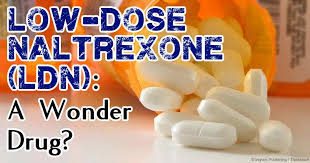If you are familiar with my practice and know that we work hard to heal and restore health in everyway possible without using prescription drugs, you may be wondering why I am excited to tell you about Low Dose Naltrexone (aka LDN). For three reasons, I believe this is a great example of a very useful drug. LDN does not mask symptoms. It addresses the issues of dysregulation of the immune system (and regulates it) and issues of inflammation (by reducing it). And finally, LDN has no known side effects other than transient effect on sleep and vivid dreams.
Since inflammation and immune dysregulation are at the root of many diseases, especially autoimmunity, clinicians are using it for a whole range of conditions involving inflammation and immune dysregulation including Hashimoto’s, Grave’s, rheumatoid arthritis, lupus, psoriasis, MS, ALS, alopecia, chronic fatigue syndrome, and neurogenerative disorders such as Parkinson’s and Alzheimer’s. LDN is also used as a complementary medicine by functional specialists for cancers, HIV/AIDS, as well as for post radiation salivary gland destruction, chronic allergic rhinitis, nerve damage, autism, shingles, weight management, infertility and migraines.
The original commercial prescription use of Naltrexone was approved by the FDA in 1984 in a 50mg dose and used for helping opiate addicts get off illegal and prescription drugs by blocking opiate receptors. It’s also used to reverse opiate overdose (e.g., heroin, morphine).
Since that time, many doctors have pioneered the use of Naltrexone at very low doses, thus the name, Low Dose Naltrexone, or LDN. One of the first was Bernard Bihari, MD, a physician in New York City who was interested in treating cancer and AIDS patients. He discovered that low doses between 3 and 4.5 mg had very beneficial effects on the immune system.
Over the last 25 years or so, there have been increasingly more clinical trials with very favorable results. Additionally, clinical and anecdotal experience is showing improvements for a wide variety of conditions. So far, two main mechanisms of LDN have been identified.
First, LDN modulates the immune system by helping the T regulatory cells balance immune function without suppressing the body’s ability to regenerate and repair. T regulatory cells are responsible for turning inflammation on and off in the body. Patients with overactive immune systems (such as asthma, allergies, and autoimmune conditions) have immune systems that get “stuck in overdrive”. LDN helps to get the system balanced again.
Second, LDN reduces inflammation in the Central Nervous System which is thought to play a significant role in fibromyalgia, other forms of chronic pain, and depression. In the Central Nervous System there are receptors found on certain brain cells called microglia. These cells can become chronically activated, resulting in neurotoxicity, which causes a cascade of symptoms that are associated with chronic pain, fatigue, mood disorders, and cognitive problems. LDN reduces inflammation and quiets the microglia, which slows or stops the cascade of symptoms.
Another important advantage is that LDN is safe for almost everyone. People who regularly use opioid drugs or medication should not take LDN (however, there is a new FDA approved morphine that has a VERY low dose of LDN combined with it). LDN is not addictive and can be stopped abruptly without harm or withdrawal.
While most conventional healthcare practitioners are not familiar with LDN, it’s gaining popularity in the functional medicine realm. At TWIHW, we’ve been prescribing LDN for several years for all sorts of health issues. Because it’s specially compounded, it’s not covered by insurance. Dosing is very personalized for each patient. In our practice, dose varies from 0.5mg per day, up to 4.5mg twice daily. It can be formulated into capsules, sublingual drops, topical cream, nasal spray, and eye drops, depending on the purpose or need.
Studies with LDN have been especially encouraging for treating Crohn’s with over a 70% remission rate, and even complete mucosal healing as evidenced by colonoscopy in some cases.
Because naltrexone has been without patent protection for many years, no pharmaceutical company will bear the expense of the large clinical trials necessary for FDA approval of LDN’s new special uses. There are at least 2 new FDA-approved and patented combination drugs (one mentioned above, and a new weight management drug called CONTRAVE®) which include LDN. They always find a way!!
Resources:
https://www.ldnscience.org/patients/qa/how-does-low-dose-naltrexone-work
http://www.lowdosenaltrexone.org/
https://chriskresser.com/low-dose-naltrexone-ldn-as-a-treatment-for-autoimmune-disease


